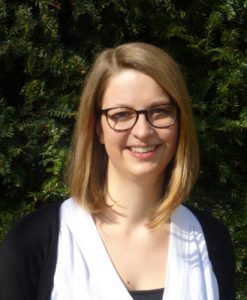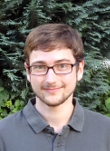
(photo: H. Mayer)
You are reading an immunology blog and we are featuring a trained mathematician. What the hell went wrong here? Nothing at all! You just encountered the first article of our new series: “Going interdisciplinary – Beyond the borders of Immunology”. Our interviewee is Hannah Mayer, who is about to finish her PhD at the Institute of Applied Mathematics with Prof Anton Bovier working on modelling of T cell activation and adoptive cell transfer. Here, Hannah tells us how she got sparked by biological questions, how she manages to bridge two quite different areas in the large field of natural sciences and finally ended up starting to work for Bayer Healthcare this May.
When biology and maths come together
Although Hannah was interested in biology from schooldays on, she decided to study mathematics to remain more flexible. She stayed open-minded during her studies, though – her minor subjects were philosophy and chemistry. When Hannah was looking for a topic for her diploma thesis in 2010, her interest in biology revived and she approached Prof Anton Bovier. That was the first time when biology and maths really came together for her.
Encountering a foreign discipline isn’t a trivial thing. “Learning a language, somehow,” was one of the greater challenges, Hannah reports. During her diploma thesis, school knowledge on cell biology and the “Pocket Atlas of Immunology” were of help to her and fortunately, most mathematical papers introduced the biological terms. Since Hannah enjoyed the work during her diploma thesis, she stayed with Prof Bovier and followed up on the previous studies during her PhD. Additionally, Hannah also attended immunology and molecular biomedicine lectures to get more biological background knowledge.
Modelling immunological processes
“The focus of my PhD project was modelling of immunological processes,” Hannah explains. “From the mathematical point of view it was about probability theory and from the biological point of view it was immunology, in particular T cell activation.”
“The idea of my first project was to understand how T cells are able to recognise foreign structures ,” which obviously is a big and very general question. “When we started, we didn’t know how complex everything really is,” Hannah admits, especially because this project was not in close collaboration with an immunologist when it started. However, in addition to personal contacts, the establishment of the ImmunoSensation Cluster fostered and intensified the collaborations between the mathematical department and immunologists a lot, Hannah believes. A perfect example for close cooperation is another project of Hannah, which was performed in collaboration with Prof Thomas Tüting and Prof Michael Hölzel about adoptive cell transfer therapy of T cells for melanoma.
Pushing mathematical and biological frontiers
Hannah gets a lot of motivation of her interdisciplinary work because she sees how mathematics can be applied to a specific biological question. “Before the PhD I had no idea that immunology has something to do with cancer or diabetes,” Hannah reports and she values her broadened horizon.
Hannah hopes that her research pushes mathematical as well as biological frontiers. The investigation of biological questions led to new mathematical questions – following those questions up and generalising them resulted in a publication in a sheer mathematical journal (for the ones who dare: http://alea.impa.br/articles/v12/12-21.pdf). Concerning biological frontiers, Hannah points out that it was nice to see that, “without assuming many details like phosphorylation events of receptors, we could answer some general qualitative questions,” and mathematics could help to, “find out, what is really important and identify a covert structure.”
Challenges on the way to a deeper understanding of a biological system
What does Hannah appreciate about biological work? “I like the idea of a lab book,” is certainly a surprising statement, but organising thoughts and experiments that way is something Hannah has learned from biologists.
Naturally, there are also some problems which arise when people from two different areas of studies work together. The mathematicians tend to claim that a problem is not complicated enough and hence uninteresting from a mathematical point of view. Mathematicians love to generalise and don’t always care about the biological application that much. Biologists on the other hand, love to look into the details to really understand the small things.
Hannah points out, that mathematics and physics somehow developed together from the ancient Greeks on. For biology in contrast, interdisciplinary work with mathematicians has just intensified during the last century and is thus less close. In the UK however, there is a large network on “quantitative T cell immunology” which shows that interdisciplinary work can be successful and enables a deeper understanding of the structure of a biological system which would otherwise remain hidden. To get more biologists into maths, talking to mathematicians is an effective way, Hannah assumes. At least she herself learned a lot of biology by talking to many biologists.
Next step: computational life sciences in industry
How large the influence of biology was for Hannah can be deduced from her next position: Hannah will focus on computational life sciences in the development of pharmaceuticals at Bayer Healthcare. She will work on mathematical modelling of internalisation and metabolisation of pharmaceuticals. We wish her a fantastic time with her new work!
featured image: colourbox.com

Author: Christian Sieg

Pingback: New series: Going interdisciplinary – Beyond the borders of Immunology – ImmunosensationBlog
Pingback: A range of software tools to boost your research – ImmunosensationBlog